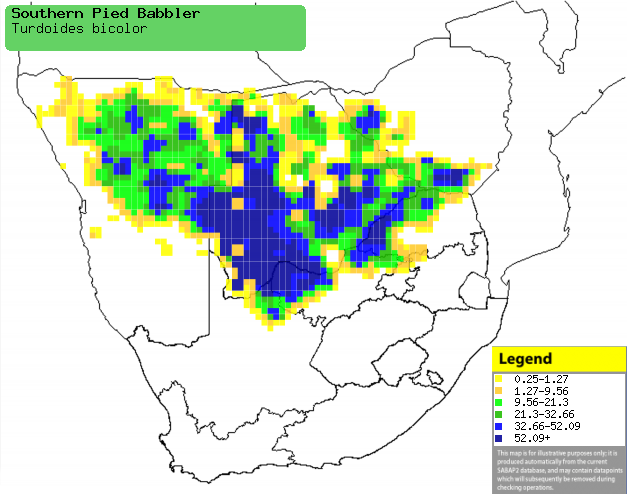|
Turdoides bicolor (Southern pied
babbler)
Witkatlagter [Afrikaans]; Siwerewere (generic term for
babbler) [Kwangali]; Letshêganôga [Tswana]; Eksterbabbelaar [Dutch];
Cratérope bicolore [French]; Elsterdroßling [German]; Zaragateiro-meridional
[Portuguese]
Life
> Eukaryotes >
Opisthokonta
> Metazoa (animals) >
Bilateria >
Deuterostomia > Chordata >
Craniata > Vertebrata (vertebrates) > Gnathostomata (jawed
vertebrates) > Teleostomi (teleost fish) > Osteichthyes (bony fish) > Class:
Sarcopterygii (lobe-finned
fish) > Stegocephalia (terrestrial
vertebrates) > Tetrapoda
(four-legged vertebrates) > Reptiliomorpha > Amniota >
Reptilia (reptiles) >
Romeriida > Diapsida > Archosauromorpha > Archosauria >
Dinosauria
(dinosaurs) > Saurischia > Theropoda (bipedal predatory dinosaurs) >
Coelurosauria > Maniraptora > Aves
(birds) >
Order: Passeriformes > Family: Sylviidae
> Genus: Turdoides
Distribution and habitat
Endemic to southern Africa, where it is locally common in
arid and semi-arid savanna woodland across northern Namibia, Botswana, Zimbabwe
and northern South Africa. It is absent from more open habitats, such as that of
the southern Kalahari Desert.
|
 |
|
Distribution of Southern pied babbler in southern Africa,
based on statistical smoothing of the records from first SA Bird Atlas
Project (©
Animal Demography unit, University of
Cape Town; smoothing by Birgit Erni and Francesca Little). Colours range
from dark blue (most common) through to yellow (least common).
See here for the latest distribution
from the SABAP2. |
Predators and parasites
There is record of a
Gabar goshawk attacking a
well-defended group of 5 juveniles. It caught one of them, only to be
viciously mobbed by the adult members of the group. After 10 minutes of fierce
attacking by the adults, the goshawk dropped the juvenile and flew 15 metres
away, where it is pinned by the babblers once again. This time it could not
escape, and after 5 more minutes of vigorous pecking on its head and neck the group left the goshawk alone. It died 36 hours later from a
fractured neck, puncture wounds, spinal cord damage and haemorrhages.
Brood parasites
It has been recorded as host of the
Levaillant's cuckoo.
Food
It eats a variety of insects supplemented with small
reptiles and amphibians, foraging in groups on the ground, flicking away leaves
and twigs in search of prey. One group member perches higher up then the rest of
the group, acting as a lookout for predators. Sentry duty is switched regularly,
so that everyone in the group gets to forage. It often joins foraging flocks
along with Red-billed and
Damara hornbills,
Crimson-breasted shrikes,
Fork-tailed drongos,
Common scimitarbills and
Red-billed bufffalo-weavers. The following food items have been recorded
in its diet:
Breeding
- Cooperative breeder, living in year-round groups of 3-15 birds, all of
whom help to build and defend the nest and feed the chicks.
- The nest is built in about 26 days by all group members, consisting of a
large bowl built of creeper and grass stems and thin twigs, lined with finer
material such as rootlets and hair. It is typically placed in a fork in the
center of a thorny tree, such as a Blue thorn (Acacia erubescens),
Black thorn (A. mellifera), Scented thorn (A. nilotica),
Umbrella thorn (A. tortilis) and Buffalo-thorn (Ziziphus mucronata).
 |
|
|
Southern pied babbler nest with eggs, Nylsvley
area, South Africa. [photo Warwick Tarboton ©] |
|
- Egg-laying season is from August-April, peaking from about
September-November.
- It lays 2-5 eggs, which are incubated for roughly 16 days.
- The chicks are fed by all group members, leaving the nest after about 16
days, after which they remain dependent on the group for about 10 more
weeks.
Threats
Not threatened.
References
-
Hockey PAR, Dean WRJ and Ryan PG 2005. Roberts
- Birds of southern Africa, VIIth ed. The Trustees of the John Voelcker
Bird Book Fund, Cape Town.
|
